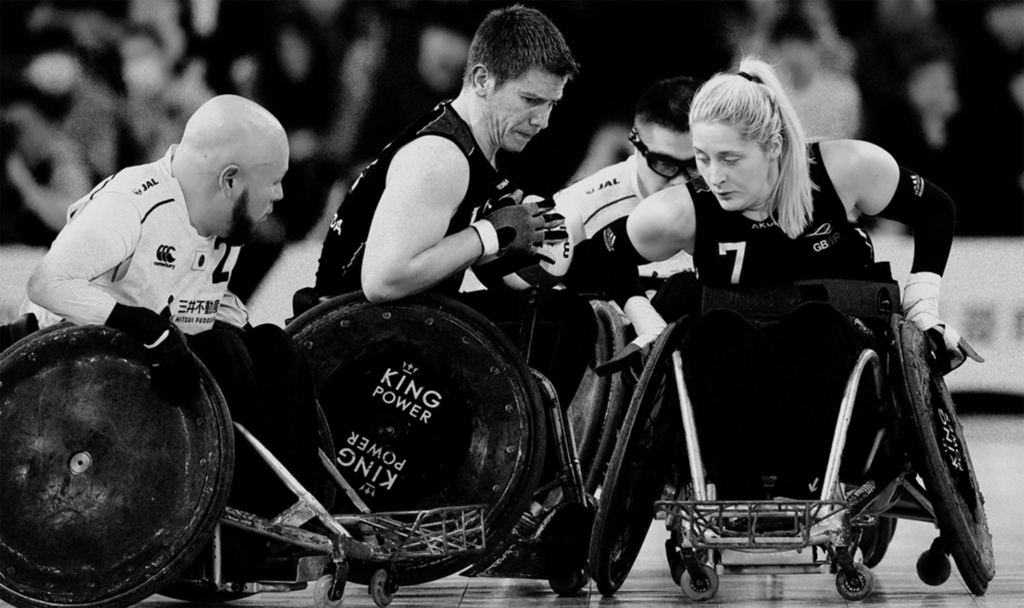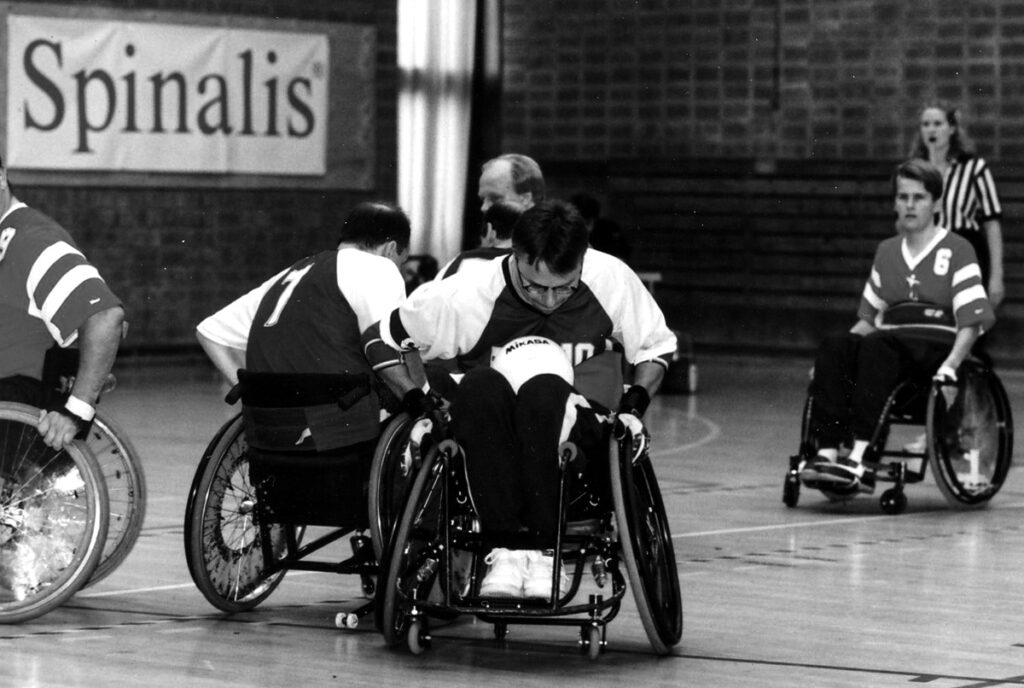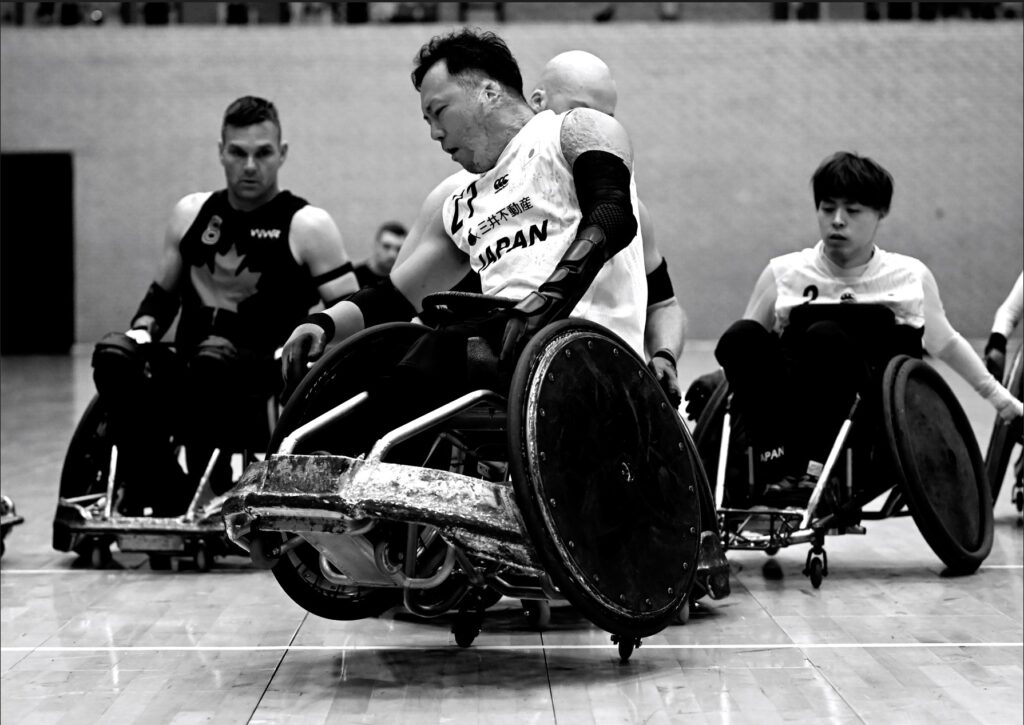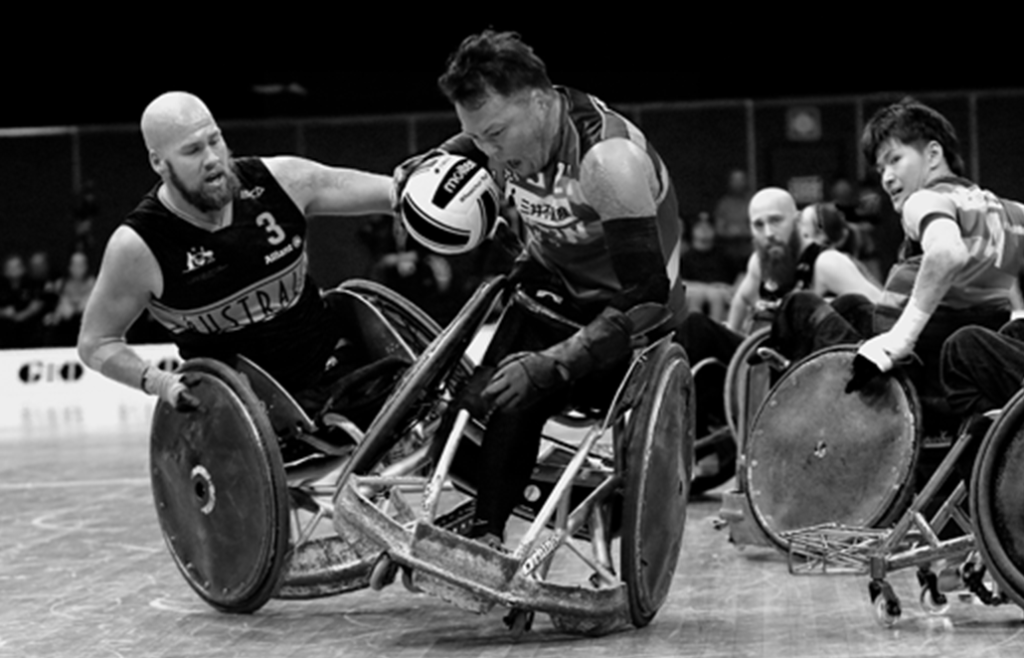About the Sport
We’re not here to inspire, we’re here to win.
WWR’s aim to be a “world leader in Para sport” includes strategic goals aimed at growth and development as well as increased involvement with sports that have developed separately to the Paralympic discipline.

A History of Wheelchair Rugby…
If you are interested in understanding how the sport of wheelchair rugby was created and developed then have a read of this chapter from the fantastic book titled “Pass the Pig’s Bladder”. If you don’t know what this reference means then have a read of the full book.
It’s an interesting read and takes you through its conception in Canada, through North America and then how it came to Europe then the rest of the world. How it started with a few people in a local gym, to inclusion in the Paralympic Games. Created through the memories of many people who were or still are involved in the sport over the previous five decades.
WWR President, Richard Allcroft said, “It’s really important to capture these memories of the sports early beginnings and the people involved. Understanding our history helps with the future of the game. Whilst new disciplines evolve it is the Paralympic discipline of wheelchair rugby that has seen the growth of our wheelchair rugby family across the globe.”
“IN THE BEGINNING
February 1976, Winnipeg, Manitoba, Canada. As the winter sun fades, the temperature falls to minus 11 degrees. Duncan Campbell manoeuvres from the car passenger seat into his wheelchair…”
The chapter continues with some great stories. Take the time and read more.
David Pond, former CEO of Great Britain Wheelchair Rugby writes on the history of wheelchair rugby in ‘Pass the Pig’s Bladder’ a celebration of 200 years of rugby football. By kind permission of David and the Rugby School you can read the full chapter here:
The full book, in both hardback and softback, can be purchased online here:
https://www.rugbyschoolshop.com/product/pass-the-pigs-bladder/
The contents of the chapter are not to be used in any way without the express permission of its authors.


The following section provides information on the different disciplines:
Paralympic Wheelchair Rugby
The foundation of WWR and is the original sport of wheelchair rugby, developed in 1977 and has expanded around the world since then.
Low Point Rugby
Based on the principles and rules of the Paralympic discipline. Athletes compete with classification of 1.5
or less.
Wheelchair Rugby 5s
The newest discipline to be developed giving more people the opportunity to enjoy the benefits of organised sports.
Invictus Games
Wheelchair Rugby has been included in every Invictus Games since 2014.
Paralympic Wheelchair Rugby
Paralympic Wheelchair Rugby is a team sport for athletes of any gender with an impairment. A unique sport created by athletes with disabilities. Athletes compete in teams of four to carry the ball across the opposing team’s try line. Contact between wheelchairs is permitted, and is an integral part of the sport as athletes use their chairs to block and hold opponents.
Wheelchair Rugby athletes compete in manual wheelchairs specifically designed for the sport. Athletes must be eligible to participate in accordance with the classification rules of the sport. A full medal sport at the 2000 Sydney Paralympic Games, with thirty countries competing in international competition and many more developing national programs.
History of Wheelchair Rugby
Wheelchair Rugby was invented in 1977 in Winnipeg, Canada by a group of quadriplegic athletes who were looking for an alternative to wheelchair basketball. They wanted a sport which would allow players with reduced arm and hand function to participate equally.
The sport first appeared outside of Canada in 1979, at a demonstration at Southwest State University in Minnesota. The first Canadian National Championship was held that same year. The first team in the United States was formed in 1981, and the first international tournament, bringing together teams from the United States and Canada, was held in 1982. Throughout the 1980’s, other local and national tournaments took place in various countries. The first international tournament with a team from outside North America was held in 1989 in Toronto, Canada. With teams from Canada, Great Britain and the United States, this was a breakthrough for developing international competition and cooperation. In 1990, Wheelchair Rugby appeared at the World Wheelchair Games as an exhibition event, which helped fuel the sports rapid growth and popularity internationally.
In 1993 with 15 countries actively participating, wheelchair rugby was recognised as an official sport for athletes with a disability, and the International Wheelchair Rugby Federation (IWRF) was established as a sport section of the International Stoke Mandeville Wheelchair Sports Federation. That same year, seven countries participated at the Stoke Mandeville International World Wheelchair Games.
In 1994, Wheelchair Rugby was officially recognised by the International Paralympic Committee (IPC) as a Paralympic sport. The first Wheelchair Rugby World Championships were held the following year in Nottwil, Switzerland with eight teams competing. In 1996, Wheelchair Rugby was included as a demonstration sport in the Atlanta Paralympic Games with 6 countries competing. In 1998, Toronto, Canada hosted the second IWRF Wheelchair Rugby World Championship, and 12 countries attended.
Wheelchair Rugby was recognised as a full medal sport for the first time at the 2000 Paralympic Games in Sydney, Australia. World Championships and the Paralympics are held every 4 years.
Currently, there are more than forty countries that actively participate in the sport of wheelchair rugby, or who are developing programmes within their nation.

Guidelines
Who can play?
For eligibility to play Paralympic Wheelchair Rugby, individuals must have an impairment which affects the arms and legs. Athletes may have a spinal cord trauma, cerebral palsy, muscular dystrophy, amputations, polio, and other neurological conditions with full or partial paralysis of the legs and partial paralysis of the arms. Any gender competes within the same team and competitions.
Athletes are assigned a sport classification based on their level of impairment; teams must field athletes with a mix of classification values, allowing players with different functional abilities to compete together.
The WWR International Rule is applicable in relation to athletes identifying as female. For each female player on the court a team will be allowed an extra 0.5 points over and above the 3.5 points for the team.
What equipment is needed?
Athletes compete in manual wheelchairs that are specifically built for the sport. The rules include detailed specifications for wheelchairs to ensure safety and fairness. In international competition, all wheelchairs must meet these requirements.
To begin playing, any manual wheelchair may be used, although the game is easier when played in a lightweight sports wheelchair.
The sport is played with a round ball. Due to the unique nature of the sport and the athletes’ impairments, a round ball ensures that a game flows better due to the more predictable nature of the bounce. A round ball is also easier to throw and catch which is a major dynamic within the sport.
Two posts are used to mark the key areas at the end of each court. A game clock is also required to time the periods of play, penalties, and time-outs.
What facilities are required?
Wheelchair Rugby is played indoors on a court measuring 15 metres wide and 28 metres long. Hardwood is the preferred surface, although other surfaces can be used. The playing surface must be accessible to people in wheelchairs.
Low Point Wheelchair Rugby
Low Point Wheelchair Rugby is a team sport for athletes of any gender with an impairment. The maximum classification points of any individual athlete must not exceed 1.5 and the total number of classification points on court at any one time must not exceed 3.5.
History
Low Point Wheelchair Rugby has been around almost as long as the Paralympic discipline. Developed for athletes with a classification of 0.5, 1.0 and 1.5 (affectionately referred to as “low pointers”), this version of the sport allows athletes who normally compete in a defensive role the opportunity to handle the ball, work in an attacking role, and score tries against other low point teams. The skills learned here have dramatically improved low pointers abilities, and have certainly enhanced their role in the Paralympic discipline.
The World Games in Birmingham, Alabama in July 2022 showcased the Low Point game on the world stage in the multi-sport event. This was the first time that a sport with athletes who have an impairment appeared at the World Games – Link
Low Point Wheelchair Rugby will also take place at The World Games in Chengdu, China in 2025.
International competition has taken place over many years, driven by the passion of the low point athletes. WWR’s aim is to grow the sport and develop more formal structures for international competition so that as the sport grows nationally, there is a natural pathway from grassroots to higher performance.
Guidelines
Who can play?
Athletes must meet the eligible impairment types for athletes who participate in sport in the Paralympic discipline and be classifiable under WWR sport classification rules.
The maximum classification points of any individual athlete must not exceed 1.5 and the total number of classification points on court at any one time must not exceed 3.5.
Equipment, rules and facilities
Wheelchair Rugby athletes compete in manual wheelchairs specifically designed for the sport. The WWR International Rule is applicable in relation to athletes identifying as female.
For each female player on the court a team will be allowed an extra 0.5 points over and above the 3.5 points for the team.
Equipment, rules and facilities are comparable to the Paralympic discipline.
Wheelchair Rugby 5’s
Wheelchair Rugby 5s is a team sport for athletes of any gender with an impairment. Contact between wheelchairs is permitted, and is an integral part of the sport as athletes use their chairs to block and hold opponents.
As the name suggests, WR5s includes 5 athletes on court, whereas the Paralympic discipline has 4. WR5s is open to anyone with a physical impairment. Whilst the Paralympic discipline is at the heart of WWR’s mission, the introduction of WR5s allows the sport of wheelchair rugby to be introduced to a wider audience, giving more people the opportunity to enjoy all the benefits that come with participating in organised sports.
History
The sport was developed by Great Britain Wheelchair Rugby (GBWR). It was introduced to provide greater opportunities for people to be involved with wheelchair rugby. Launched in December 2017, tournaments were held throughout the following year with 10 teams participating. This grew through 2019 and 2020, with 20 teams registered nationally in GB.
In 2020, WWR invited GBWR to present to Member Nations about WR5s and it was received well. Some of the Member Nations were interested and wanted to understand more. In particular, Korea had been developing an “Open Wheelchair Rugby” discipline to look at how they could introduce more people to wheelchair rugby.
Korea had been experiencing challenges with significant damage to wheelchairs and the potential for athletes to be injured due to the nature of this open discipline. WWR worked with Korea and GB to facilitate the trial of WR5s within Korea’s national development programme. This took place successfully in 2020 and 2021 and the potential for the first international match to take place was only delayed due to the Covid-19 pandemic.
Guidelines
Who can play?
Whilst the concept was to provide opportunities for those athletes that do not classify into the Paralympic discipline, it was found that over 40% of players were eligible for the Paralympic discipline. This provides an excellent opportunity for an overlap, enabling the different disciplines to develop.
The eligibility criteria for WR5s, has been designed to ensure competition is open to anyone with a measurable physical impairment to compete on a fair, equal and inclusive basis.
The classification rules for Wheelchair Rugby 5s differ from the Paralympic system and can be found here.
Equipment, rules and facilities
In general, WR5s rules are similar to the Paralympic discipline with some exceptions. Further information can be found here.
Invictus Games
Introduction and history
Wheelchair rugby has been included in all Invictus Games, with the first Games taking place in London in 2014. To meet the unique requirements of these Games, the rules of Paralympic wheelchair rugby were adapted. Competition often took place over just one day. Wheelchair rugby at the Invictus Games is played under WWRs International Rules with exceptions being implemented based on the competition schedule.
WWR is proud to support the inclusion of wheelchair rugby at the Invictus Games and aims to continue this inclusion.
Guidelines
Who Can Play?
Athletes compete within a “categorisation” system developed by the Invictus Games.
